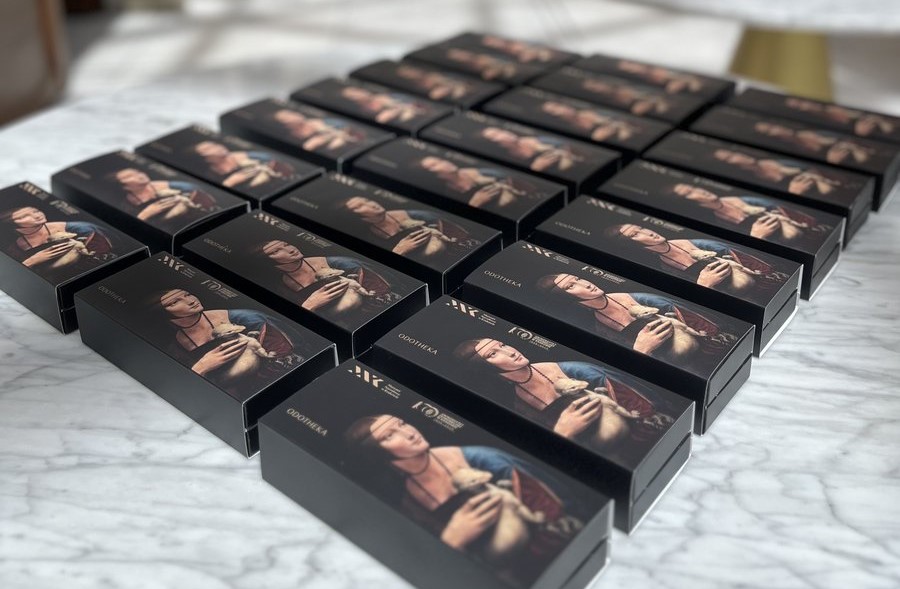The National Museum in Kraków has launched the world’s first “library of heritage smells”, through which it uses scientific methods to capture and reproduce the scents associated with historical objects.
The first fragrance produced as part of the project was extracted from Leonardo da Vinci’s Lady with an Ermine, the most famous painting held by the museum. It smells of walnut panels, paint and varnish, reports broadcaster RMF FM.
Przed nami wyjątkowy projekt! 🤩
Krakowscy i lublańscy naukowcy, we współpracy z muzealnikami, pracują nad Odotheką — pierwszą na świecie biblioteką zapachów obiektów zabytkowych. Pierwszym zapachem w kolekcji jest zapach
“Damy z Gronostajem” ✨ pic.twitter.com/K5dbnVG6Mo— Muzeum Narodowe w Krakowie (@MNKrk) June 18, 2024
The project, called Odotheka and conducted in cooperation with the National Museum of Slovenia in Ljubljana, will archive the smells of ten objects, including the works of famous Polish painters and the snuffbox of one of Slovenia’s national poets.
“The fragrance is a compilation of information about the painting – its technique, history and conservation materials,” Elżbieta Zygier, chief curator of the National Museum in Kraków, told broadcaster TVN.
The process of extracting the first scent took nine months, during which it was collected from the surface of the painting and tested in a laboratory. Using advanced measuring equipment as well as their own sense of smell, scientists were able to separate the compounds making up the scent and name them.
This is how the scent of the Lady with an Ermine was identified. But it could not be sprayed in the exhibition room for safety reasons. Instead, it has been embedded in a special felt-tip pen and placed near the painting for visitors to smell.
The jewel of Princes Czartoryski Museum Cracow. Amongst many treasures fr Ottoman tents to Rembrambts this.1798 Pr Adam Czartoryski bought this Lady with an Ermine by Leonardo da Vinci. Its teenaged lover of duke of Milan: Cecilia Gallerani. But i adore her ermine. Only da… pic.twitter.com/REelhcvzqU
— S Sebag Montefiore (@simonmontefiore) April 11, 2024
“The use of multiple senses makes the exhibition very attractive,” Zygier told broadcaster RMF. “Scent certainly also influences the emotions of visitors.”
The fragrance can also make the exhibition more accessible to people with visual impairments, Tomasz Sawoszczuk, who coordinates the research part of the project at the Kraków University of Economics, told TVN.
The declared aim of the Odotheka project – which is financed by Poland’s National Science Centre and the Slovenian Research Agency – is to archive “olfactory heritage”, meaning heritage relating to the sense of smell, through “historical evaluation, chemical analysis and odour reproduction”.
How do we preserve our experiences of historic libraries? In the first of @odeuropa + Odotheka project collaborations, @vic_toriane & @EmmaPaolin record the smellscape of Amsterdam University Library/Allard Pierson Special Collection reading room @matijastrlic #olfactoryheritage pic.twitter.com/FC8TVI5qJQ
— Smell of Heritage (@ucqbbem) June 2, 2022
“It will be a library of knowledge about the scent of a given heritage object, taking into account the historical context,” Sawoszczuk told the Polish Press Agency (PAP) in 2022, when the project was in its early stages.
“It will be a collection of recipes mapping the scent of a particular object,” he added. “We will learn what chemical compounds need to be mixed to obtain a particular odour.”
In total, the project will extract and archive the scents of ten heritage objects, including the works of Polish artists Stanisław Wyspiański, Olga Boznańska and Alina Szapocznikow, as well as the snuffbox of France Prešeren, one of Slovenia’s national poets and author of the country’s national anthem.
Lady with an Ermine was produced by Leonardo da Vinci around 1489-1491. It was acquired in 1798 by Polish Prince Adam George Czartoryski, thereby becoming part of the famous Czartoryski collection. It is now displayed at the Czartoryski Museum in Kraków, which is part of the National Museum.
Poland's oldest museum, the Czartoryski, has re-opened following a ten-year renovation.
The institution, which has survived war, exile and occupation, is now embarking on a new era following a controversial acquisition by the state https://t.co/i1rl60FcH8
— Notes from Poland 🇵🇱 (@notesfrompoland) December 21, 2019

Notes from Poland is run by a small editorial team and published by an independent, non-profit foundation that is funded through donations from our readers. We cannot do what we do without your support.

Agata Pyka is a former assistant editor at Notes from Poland. She specialises in Central and Eastern European affairs, cybersecurity, and investigative reporting. She holds a master’s degree in political communication from the University of Amsterdam, and her work has appeared in Euractiv, the Balkan Investigative Reporting Network (BIRN), and The European Correspondent, among others.



















